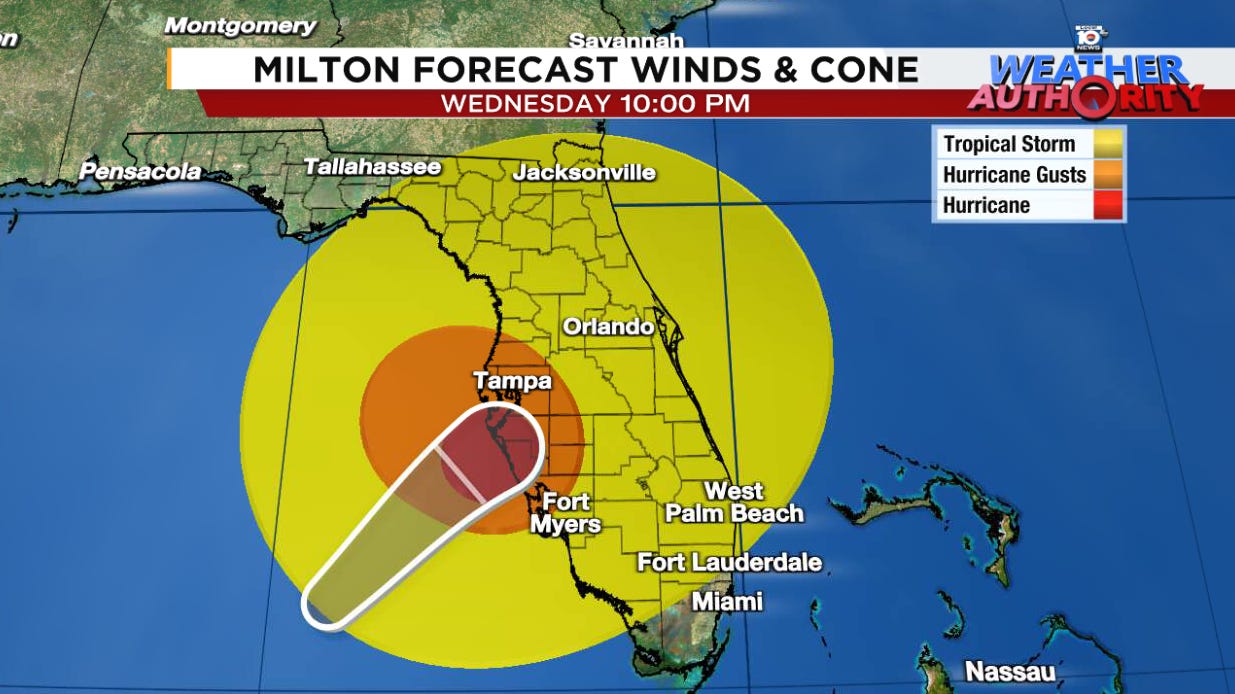Milton Closes In, Nightmare Forecast Unfolding for West-Central Florida
National Weather Service: “Time is now perilously close to running out and [preparations to protect life and property] should be rushed to completion”

Hurricane Milton continued its dangerous trek as a Category 5 hurricane during the predawn hours Wednesday as it accelerated across the eastern Gulf toward Florida’s west coast.
The eye of the now Category 4 hurricane is forecast to come ashore during the midnight hours today – either late Wednesday evening or very early Thursday – somewhere between the Tampa Bay Region to the north and Venice and Englewood to the south, with places like Bradenton, Sarasota, Anna Maria Island, Longboat Key, and Siesta Key squarely within its path.

Areas immediately near and to the south of where Milton’s center lands are forecast to see up to 15 feet of catastrophic storm surge, a level of devastation unknown to the most at-risk spots that escaped the worst of Hurricane Ian only two years ago.
It cannot be stressed enough how crucial Milton’s center track is to where the worst storm surge – historically the deadliest and most destructive calling card of a hurricane – strikes. A track slipping toward the south side of the forecast cone would spare the Tampa Bay Region the worst coastal flooding but would also deflect Milton’s most devastating coastal flooding toward Charlotte Harbor, Gasparilla Island, and Boca Grande.
On the other hand, a northward move toward St. Pete could push life-threatening and catastrophic surge squarely into Tampa Bay.
Although the track is integral to the storm surge, it’s important to keep in mind that even the best forecast models simply cannot nail down the precise details, even hours in advance. The average forecast error 12 hours before landfall is still around 25 miles. Hurricane tracks often do squirrely things as they interact with the coast and encounter the frictional influence of land, so while the wobbles matter, they’re also impossible to accurately predict.
Follow the advice of local officials and if you’re being asked to evacuate low-lying areas, please do so without hesitation. The window to safely leave is rapidly closing, but in most cases you don’t have to go far inland to be in a higher place where you can safely ride out the hurricane.
Milton’s growing influence
Hurricane hunters early Wednesday along with land-based radar and microwave satellite indicated Milton was beginning another eyewall replacement cycle. Whether or not it completes this eyewall replacement – whereby its smaller inner ring of intense winds and weather is replaced by a larger outer ring – before landfall is to be seen, but it indicates we’ll see the hurricane progressively grow in size as it approaches the coastline.

Even though Milton’s maximum winds will decrease today due to increasingly strong upper-level winds and the ongoing eyewall replacement cycle, it will stay a powerful hurricane, with its expanding wind field worsening its destructive footprint right as it hits land.
Tropical storm conditions – winds of 40 mph or higher – will cover most of Florida’s peninsula by this evening but Milton’s most damaging core of winds will largely follow its track near and south of the I-4 corridor between Tampa and Daytona Beach.
Hurricane conditions – winds of 74 mph or higher – can be expected for inland locations across central Florida between Lake Okeechobee and Ocala, including the Orlando metro, over to Melbourne and Vero on the east coast for the morning to early afternoon hours on Thursday.
Tornadoes will also be a threat today ahead of Milton from the I-4 corridor southward, especially along Florida’s southwest counties.
Southeast Florida – including the urban I-95 corridor between Miami and Fort Lauderdale – will see gusty winds as high as 40 to 50 mph, which should peak late Wednesday into the early morning hours Thursday, but damaging winds aren’t expected this far south.
Big rains near and north of Milton’s center
Forecast models continue to advertise widespread and potentially catastrophic flash flooding as Milton moves inland. The stalled front helping to steer Milton across the peninsula will also be a focus area for heavy rains and widespread flash flooding over the next 24 hours.
Similar to the storm surge threat, the track of Milton will also influence where its heaviest rains fall, but unlike the surge threat, the heavy rain threat will fall near and to the north, not south, of the center track, since drier air will be wrapping around the south side of Milton as it races across Florida.
This unfortunately puts the Tampa metro squarely at the center of what could be Milton’s heaviest rainfall, with the National Weather Service now forecasting up to 16 inches of rainfall across the area which could cause widespread and catastrophic flooding in the Tampa area by as early as tonight.
The core of heaviest rains could then move over the Orlando metro, where over a foot of rain is forecast.
Similar to the surge, any small deviations in track could have a noticeable influence on where Milton’s swath of heaviest rains sets up.
No looming threats behind Milton for now
Mercifully, after the most active early October on record, the Atlantic should simmer down some next week in the wake of Milton. Leslie is remarkably still a hurricane over the open Atlantic but is turning out to sea.
Meanwhile the two other areas being marked by NHC this morning pose no significant threats to land.








